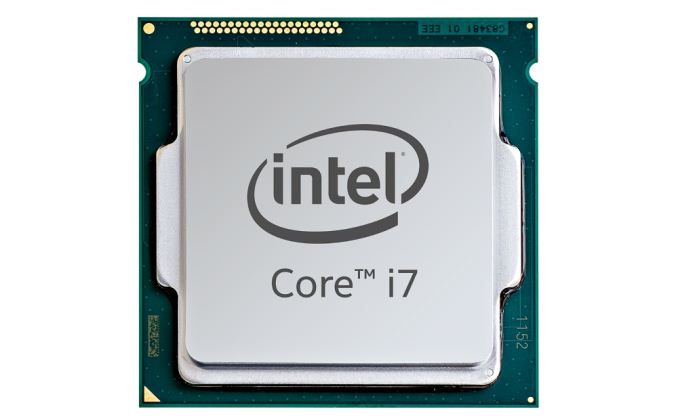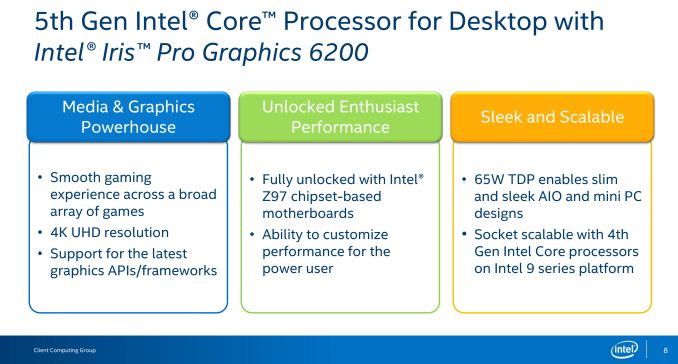The Intel Broadwell Desktop Review: Core i7-5775C and Core i5-5675C Tested (Part 1)
by Ian Cutress on June 2, 2015 7:45 AM ESTBroadwell-DT: Initial Thoughts
The new Broadwell desktop processors are somewhat out of sync with our regular expectations from Intel. Due to issues surrounding the 14nm node, as well as the cost, the whole Broadwell line from tablet to table-top has come out slower and more staggered than any Intel release in recent memory. As a result, the initial launch from Intel today is a pair of 65W desktop socketed models backed up with three 65W soldered down models whose true heritage is a chip primarily designed for large laptops and all-in-one devices.
Normally we would expect a range of desktop models from 35W up to 88W or higher, but socketed Broadwell-DT today only exhibits two units at 65W. This immediately puts a slight damper on those expecting to upgrade from Haswell’s high-end, or those wanting to go from something like a Pentium G3258 on Haswell to Broadwell’s top SKU. As a result, we have to keep our expectations in check – 65W should on paper perform nearly as well as an 88W part would, except it would be reduced by several hundred MHz. Meanwhile as these processors are also fully-unlocked and overclockable, we're left to ponder whether or not the stock frequencies actually matter in that case.
Due to the differential tangent at play, these processors also exhibit Intel’s best integrated graphics package, Iris Pro (GT3e), previously reserved only for soldered down/laptop/mini-PC orientations. This graphics package comes with largest number of execution units available from Intel, 48, alongside 128MB of eDRAM that acts almost like an L4 cache. This helps alleviate memory bandwidth pressure by providing a large(ish) pool near the CPU but with lower latency and much greater bandwidth than main memory. The eDRAM has the greatest effect in graphics, but we also saw some moderate increases in our non-3D regular benchmark suite.
The benefit of the graphics package, Iris Pro 6200, means that Broadwell-DT takes the crown as the fastest socketed graphics available. Our testing showed that the even the second-tier socketed SKU, the i5-5675C, outgunned the previous title holder, AMD’s A10-7870K. Despite having the i7-5775C in to test, due to time and firmware issues, we were unable to run the numbers on the integrated graphics but will do so in a later piece.
The key element to Broadwell-DT is not to consider it a natural successor to Haswell. It doesn't so much replace Haswell-K at this time, so much as it occupies a space Intel has left neglected since the launch of Haswell – the ultimate Intel integrated graphics solution. For users on integrated graphics, where money is no object, Intel now offers you the option to combine the regular CPU performance associated with Intel and a GPU that has the added performance benefits of on-chip, high-bandwidth eDRAM. The only question is whether that combined performance is worth the potential cost, and some would say no, pointing at a combined APU + GPU solution for equivalent or better gaming performance for the same price.
Pricing for the i5-5675C is listed as $276, slightly higher than the price of the i5-4690K which is at $236 on Amazon (reduced from $265). The i7-5775C is a bit higher at $366, also a margin higher than the i7-4790K which is $339 (reduced from $380). This makes Broadwell a tough sell right now in most circumstances unless you are absolutely limited to integrated graphics and want the best solution possible in a configurable PC. Given that Intel has also mentioned Skylake in their recent Computex keynote, it implements an abnormal situation that Intel has never been in with a new platform being talked about in the same breath. We have been told that these parts exist because users wanted them, and it has been interesting to see just how the added eDRAM changes the performance with discrete graphics in the mix.












196 Comments
View All Comments
Flunk - Tuesday, June 2, 2015 - link
The 5820K is even available for < €400.ImSpartacus - Tuesday, June 2, 2015 - link
And it's not THAT expensive. It's certainly not cheap, but it's reasonable considering Intel's dominance.bug77 - Tuesday, June 2, 2015 - link
I would love to see a quad core clocked higher (or with better IPC). I don't use highly parallel software that much and I have no use for an integrated GPU.Sadly, with no competition, Intel has just been pumping the GPU for 4 generations in a row. Not that I blame them.
Taneli - Tuesday, June 2, 2015 - link
Improving single threaded performance is extremely hard, just ask AMD. I'd expect improvements of 5-10% per generation for the next few years.bug77 - Tuesday, June 2, 2015 - link
They could still raise the clock speed. Intel CPUs could hit 4GHz on air for years. Even the top-level Haswell can do it, but it's 4 core+HT part. If I could replace my i5-2500k with a 4GHz quad-core, that would be good enough for me. Removing the integrated GPU from the equation would yield even more thermal legroom for the CPU. But it's not happening. With CPU performance securely in their hands, Intel is trying to secure positions in GPU and mobile markets (they'd be crazy not to at least try to diversify).Yet raising the clock speed conflicts with higher IPC. Because raising clock speed needs a longer pipeline and a longer pipeline means taking a more serious hit for branch mispredictions. AMD has managed to seriously raise IPC with AthlonXP. Intel did it with their Core architecture. And nothing happened ever since. Because there's no more pressure on Intel and AMD doesn't have the cash to invest anymore.
swaaye - Tuesday, June 2, 2015 - link
You don't know that the GPU is impeding clock rate.Increases to clock rate increase power consumption dramatically. You can always overclock Broadwell yourself.
IPC has been steadily improving. Core 2, and anything from AMD, are far behind at this point.
bug77 - Tuesday, June 2, 2015 - link
"IPC has been steadily improving. Core 2, and anything from AMD, are far behind at this point."Not really. If you look here: http://www.anandtech.com/show/7003/the-haswell-rev...
You'll see there's usually less than 10% gained (watch the i7 3.5GHz parts). And that's spread over three generations. Broadwell bring another 2-3%.
And yes, AMD has been playing the same game, only they're stuck in their Athlon64 days.
MrSpadge - Tuesday, June 2, 2015 - link
Dude, Intel is offering exactly this with i7 4790K. A really highly clocked quad core. Use your external GPU and the iGPU won't consume any power nor limit clock speed. In fact it makes the die larger and thus helps cooling a bit.sonicmerlin - Tuesday, June 2, 2015 - link
Oh please. What a garbage excuse. "It's hard"? Intel's more than doubled IPC/Watt in their mobile chips over the last 3-4 years. They just don't care about high end IPC because they have no competition.vision33r - Tuesday, June 2, 2015 - link
That is what the XEON offers a better price and value than the X58xx line if you don't need unlocked performance. You can buy many XEON 6 cores cheaper than the X58xx line.